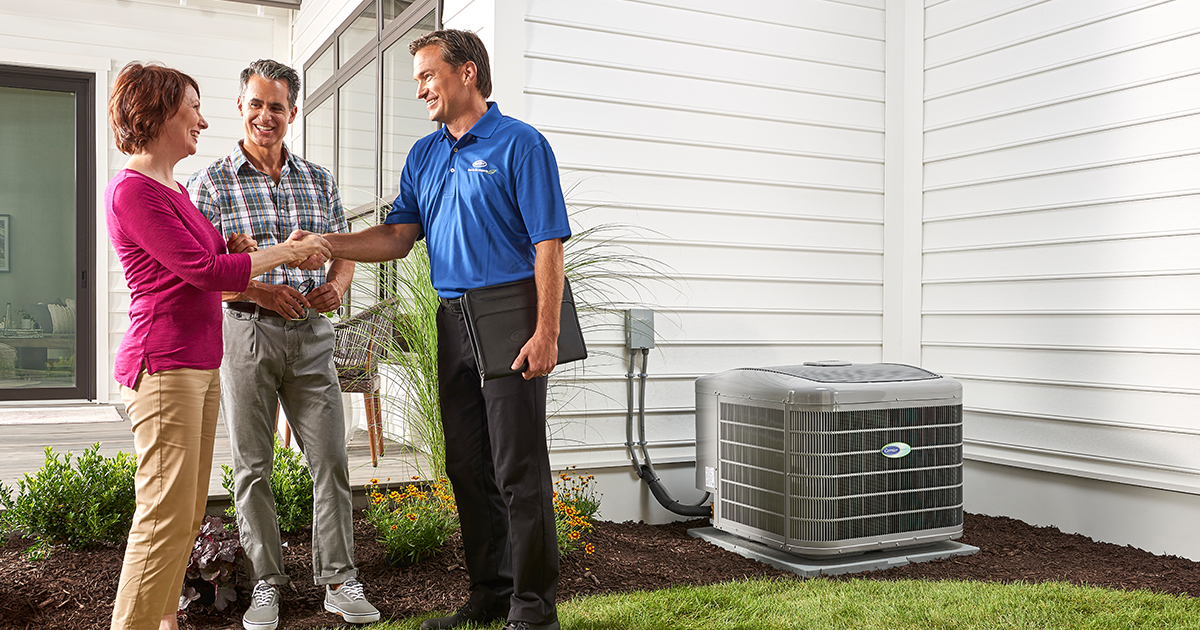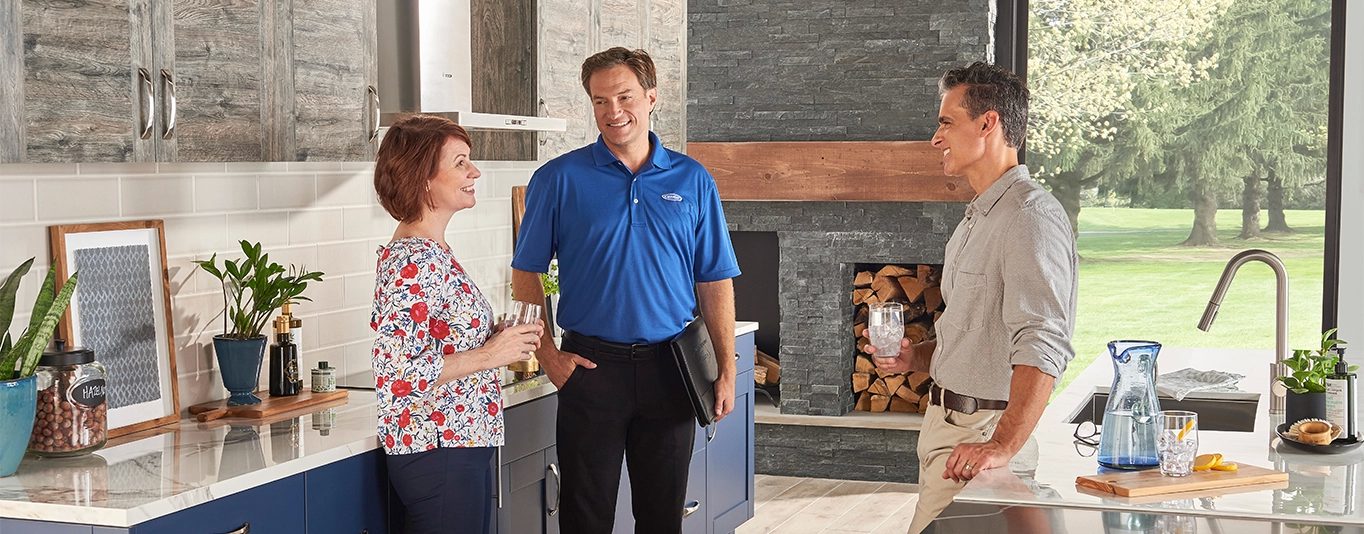AIR CONDITIONER REPLACEMENT

WHAT YOU NEED TO KNOW ABOUT REPLACING YOUR AIR CONDITIONER
Replacing your air conditioning (AC) system is a significant investment that can significantly enhance your home’s comfort and energy efficiency. Understanding the process, recognizing the signs that indicate it’s time for a replacement, and knowing what to expect can help you make an informed decision. Here’s a detailed guide to help you through this essential home improvement project.
RECOGNIZING THE SIGNS; WHEN IS IT TIME TO REPLACE YOUR AC?
- Age of Your System: Most air conditioning units have 10 to 15 years of lifespan. If your system is nearing or has surpassed this age, it’s likely time to consider a replacement. Older units are less efficient and more prone to breakdowns.
- Rising Energy Bills: An increase in energy bills without a corresponding change in usage often indicates your AC is losing efficiency. Newer models are designed to be more energy-efficient, saving you money on utilities.
- Frequent Repairs: If you’re constantly calling for repairs, replacing your unit might be more cost-effective. Frequent breakdowns not only disrupt comfort but also add up financially over time.
- Inconsistent Cooling: If some rooms are cooler than others or the system struggles to maintain a comfortable temperature, it’s a sign of declining performance. A new system can ensure consistent cooling throughout your home.
BENEFITS OF UPGRADING YOUR AC
- Improved Energy Efficiency: Modern AC systems use less electricity while providing the same or better cooling capacity. This energy efficiency leads to significant long-term savings on your energy bills.
- Enhanced Comfort and Indoor Air Quality: New systems better control temperature, humidity, and air circulation, improving overall comfort and air quality in your home. They also operate more quietly
- Environmental Impact: Energy-efficient systems reduce your carbon footprint, contributing to environmental sustainability.
- Smart Controls: Many modern units have smart controls and connectivity, allowing you to monitor and manage your system remotely via mobile devices.
- Increased Home Value: A new AC system can boost your property’s value, making it more appealing to potential buyers.
FURNACE REPLACEMENT

WHAT YOU NEED TO KNOW ABOUT FURNACE REPLACEMENT
Replacing your furnace is a significant home improvement project that can greatly enhance your comfort and energy efficiency. It’s also a significant investment that we don’t take lightly. Recognizing the signs that indicate it’s time for a replacement and understanding your furnace type options are beginning steps in learning about replacing your furnace.
SIGNS INDICATING A FURNACE REPLACEMENT IS NEAR
- Age of the Furnace: Most furnaces have a 15 to 20 years lifespan. If your furnace is nearing or has surpassed this age, it’s likely time to consider a replacement. Older units are less efficient and more prone to breakdowns.
- Frequent Repairs: If you find yourself frequently calling for repairs, replacing your furnace might be more cost-effective. Constant repairs not only disrupt your comfort but also add up financially over time.
- Rising Energy Bills: An increase in energy bills without a corresponding change in usage often indicates your furnace is losing efficiency. Newer models are designed to be more energy-efficient and can save you money on utilities.
- Uneven Heating: If some rooms are warmer than others or if the system struggles to maintain a comfortable temperature, it’s a sign of declining performance. A new system can ensure consistent heating throughout your home.
- Unusual Noises and Dust: Strange noises such as buzzing or rattling and increased dust or soot (in the case of oil furnaces) around the house often indicate that your furnace is on its last legs.
CHOOSING BETWEEN AN ELECTRIC AND GAS FURNACE
Both electric and gas furnaces have advantages and considerations, and the right choice for you will depend on your specific needs, budget, and home setup.
Efficiency and Operating Costs
- Electric Furnaces: Electric furnaces convert nearly all their energy into heat, making them highly efficient in energy usage. However, electricity generally costs more than natural gas, making operating an electric furnace more expensive over time. Operating costs might not be a significant concern for you if you live in an area where electricity is priced competitively.
- Gas Furnaces: Gas furnaces are typically less expensive to operate because natural gas is often cheaper than electricity. Modern gas furnaces are also highly efficient, with many models boasting Annual Fuel Utilization Efficiency (AFUE) ratings of 90% or higher. If keeping your heating bills low is a priority, a gas furnace might be the better option. At the same time, gas prices vary depending on your area and utility company.
Hookup Costs and Complexity
- Electric Furnaces: Electric furnaces are generally easier and less expensive to install. They don’t require a venting system, which can be particularly advantageous in homes that don’t already have gas lines installed.
- Gas Furnaces: Installing a gas furnace is usually more complex and expensive. You’ll need proper ventilation to handle combustion gases and a connection to a natural gas line. If your home doesn’t have a gas hookup, the installation costs can be higher.
Environmental Impact
- Electric Furnaces: The environmental impact of an electric furnace depends primarily on how your electricity is generated. If your local grid relies heavily on renewable energy sources, an electric furnace can be a more environmentally friendly option. However, the environmental benefits diminish if the electricity comes from coal or other fossil fuels.
- Gas Furnaces: While natural gas burns cleaner than other fossil fuels, it’s still a non-renewable resource contributing to greenhouse gas emissions. However, technological advancements have made modern gas furnaces more efficient and less polluting than older models.
Note: If you are looking for the most environmental option for heating and cooling your home, check out our Geothermal webpage.
Making the Right Choice
Choosing between an electric and gas furnace ultimately comes down to your specific needs and circumstances. Here are a few questions to ask yourself:
- What’s my budget for installation and operating costs? If upfront costs are a major concern, an electric furnace might be the way to go. If you’re more focused on long-term savings, consider a gas furnace.
- What’s the climate like in my area? For milder climates, an electric furnace can provide sufficient heating. In colder climates, a gas furnace’s powerful heat output will be more effective.
- Do I have access to natural gas? If your home doesn’t already have a gas line, consider the additional cost and complexity of installing one.
- How important is environmental impact to me? Consider the source of your electricity and the efficiency of the furnace models you’re considering. You may even look into Geothermal options.
THE FURNACE REPAIR PROCESS
When professional HVAC technicians are called in for furnace repairs, here’s what you may expect:
1. Initial Inspection: Technicians begin with a comprehensive furnace inspection to diagnose the problem. The inspection involves checking the thermostat settings, examining electrical connections, inspecting the burners, and ensuring that all components are functioning properly.
2. Diagnosis and Recommendations: The technician will explain the problem and recommend the necessary repairs after identifying the issue. They will also estimate the repair costs, giving you a clear idea of what’s needed to fix your system.
3. Repair Work: Depending on the diagnosis, the repair work can range from simple tasks like replacing filters or cleaning burners to more complex procedures such as repairing the ignition system or replacing electrical components. Each repair addresses the specific problem identified during the inspection.
4. Testing and Calibration: The technician will test the system once the repairs are complete to ensure it is operating correctly. They will also calibrate the thermostat and other settings to optimize performance, ensuring your home stays warm and comfortable.
5. Preventive Maintenance Advice: Finally, the technician will offer advice on preventive maintenance to help you avoid future issues. Tips include regularly changing the filter, keeping the area around the furnace clear, and scheduling semi-annual professional maintenance checks. Following these recommendations can extend the lifespan of your furnace and keep it running efficiently.
HEAT PUMP REPLACEMENT

WHAT HOMEOWNERS SHOULD KNOW ABOUT HEAT PUMP REPLACEMENT
Whether you’re considering replacing your heat pump or a different heating and cooling system, upgrading to a new, energy-efficient heat pump can significantly improve your home’s comfort and reduce your energy bills. The signs you need to replace your heat pump are the same as those for furnaces and air conditioners, including equipment age, higher energy bills, frequent repairs, inconsistent heating or cooling, and noises.
WHAT TO CONSIDER WHEN CHOOSING A HEAT PUMP
Types of Heat Pumps
Air-Source Heat Pumps: These are the most common type and work by transferring heat between your house and the outside air. They are efficient and suitable for a wide range of climates./
Ground-Source (Geothermal) Heat Pumps: These systems use the stable temperature of the ground to provide heating and cooling. They are more efficient than air-source heat pumps but also more expensive to install.
Ductless Mini-Split Systems: These are ideal for homes without ductwork. They provide flexibility in zoning and are easy to install.
Efficiency Ratings
SEER (Seasonal Energy Efficiency Ratio): This measures the cooling efficiency of the heat pump. The higher the SEER rating, the more efficient the unit.
HSPF (Heating Seasonal Performance Factor): This measures the heating efficiency. A higher HSPF rating indicates better efficiency.
Size and Capacity: Ensure the heat pump is appropriately sized for your home. An undersized unit will struggle to maintain temperature, while an oversized unit will cycle on and off too frequently, reducing efficiency and lifespan.
COMMON HEAT PUMP MYTHS
Several myths about heat pumps persist, causing confusion among homeowners. Let’s debunk some of the most common misconceptions about heat pumps to help you make informed decisions.
Myth 1: Heat Pumps Are Only Effective in Mild Climates
Fact: Modern heat pumps are designed to operate efficiently in a wide range of climates, including colder regions. Advances in technology, such as variable-speed compressors and improved refrigerants, allow heat pumps to provide effective heating even when outdoor temperatures drop below freezing. For example, cold climate heat pumps (CCHPs) are specifically engineered to perform well in colder climates, maintaining efficiency and comfort.
Myth 2: Heat Pumps Are Less Efficient Than Traditional Heating Systems
Fact: Heat pumps are among the most energy-efficient heating systems available. They transfer heat rather than generate it, which allows them to provide up to three times more heat energy than the electrical energy they consume. This makes them more efficient than traditional electric or gas heating systems. The Seasonal Energy Efficiency Ratio (SEER) and Heating Seasonal Performance Factor (HSPF) ratings of heat pumps often exceed those of conventional systems.
Myth 3: Heat Pumps Are Noisy
Fact: Modern heat pumps are designed to operate quietly. Technological advancements have significantly reduced the noise levels of both the indoor and outdoor units. In many cases, heat pumps are quieter than traditional HVAC systems. Manufacturers often publish noise levels in decibels (dB) to help consumers compare different models.
Myth 4: Heat Pumps Require More Maintenance
Fact: Heat pumps do require regular maintenance to operate efficiently, but the maintenance is not more intensive than that of traditional HVAC systems. Routine tasks include changing filters, checking refrigerant levels, and inspecting the system for any issues. Most maintenance tasks can be handled during annual service visits, ensuring the system runs smoothly year-round.
Myth 5: Heat Pumps Are Too Expensive to Install
Fact: While the initial installation cost of a heat pump can be higher than some traditional systems, the long-term savings on energy bills often offset the upfront expense. Additionally, many regions offer rebates and incentives for installing energy-efficient systems like heat pumps, further reducing the overall cost. Over time, the efficiency and cost savings of operating a heat pump can make it a more economical choice.
Myth 6: Heat Pumps Don’t Work Well in Older Homes
Fact: Heat pumps can be installed in both new and older homes. In fact, they can be an excellent retrofit option for improving the energy efficiency of older properties. Ductless mini-split systems are particularly well-suited for homes without existing ductwork, making them a versatile solution for a variety of home types.
Myth 7: Heat Pumps Only Heat the Air
Fact: Heat pumps can provide both heating and cooling, making them a versatile year-round solution. In addition to air-source heat pumps, there are also ground-source ( several myths about heat pumps persist, causing confusion among homeowners. Let’s debunk some of the most common misconceptions about heat pumps to help you make informed decisions.) heat pumps and water-source heat pumps that can utilize different sources for heating and cooling. This dual functionality eliminates the need for separate heating and cooling systems, saving space and reducing installation costs.
THERMOSTAT REPLACEMENT

WHAT YOU NEED TO KNOW ABOUT REPLACING YOUR THERMOSTAT
Your thermostat is the brain and command center of your home’s heating and cooling system. It tells your system when to run, for how long, and at what temperature. But like any technology, thermostats can become outdated or lose accuracy over time. A thermostat upgrade is worth considering if you plan to replace your HVAC system or if you’re simply looking to improve your home’s overall comfort and efficiency.
Older thermostats may lack the sensitivity or features to help your HVAC system maintain a consistent temperature throughout your home. If you’re noticing pockets of uneven heating or cooling, unusually high energy bills, or a sluggish or unresponsive thermostat, it may be time for a replacement. Modern thermostats bring improved precision and new conveniences that weren’t available even just a few years ago.
Today’s state-of-the-art thermostats offer advanced digital displays, intuitive programming, and, in many cases, smart home integration. These latest innovations mean more accurate temperature control, more convenient adjustments, and more options to manage your home’s comfort even when you’re away.
Replacing a thermostat isn’t just about obtaining the most modern features; it’s about ensuring compatibility and maximizing your HVAC system’s performance. At Precision Comfort Systems, we match your home and HVAC setup with the best-fit thermostat to make sure everything works in sync. No guesswork or wasted potential, just straightforward and dependable climate control.
Our highly trained and trusted technicians will install and configure your new thermostat the right way the first time, avoiding common DIY pitfalls like incorrect wiring or programming errors. We’ll guide you through how to use your new thermostat and take full advantage of its convenient features and benefits, ensuring your comfort and confidence from day one.
